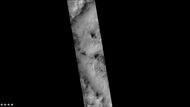Joly (crater)
Topic: Astronomy
 From HandWiki - Reading time: 6 min
From HandWiki - Reading time: 6 min
Joly is an impact crater on Mars, located at 74.7°S latitude and 42.7°W longitude in the Mare Australe quadrangle. It measures 79.9 kilometres (49.6 mi) in diameter and was named after Irish physicist John Joly (1857–1933). The name was approved in 1973, by the International Astronomical Union (IAU) Working Group for Planetary System Nomenclature (WGPSN).[1]
Spiders
During the winter, much frost accumulates. It freezes out directly onto the surface of the permanent polar cap, which is made of water ice covered with layers of dust and sand. The deposit begins as a layer of dusty CO
2 frost. Over the winter, it recrystallizes and becomes denser. The dust and sand particles caught in the frost slowly sink. By the time temperatures rise in the spring, the frost layer has become a slab of semi-transparent ice about 0.91 metres (3.0 ft) thick, lying on a substrate of dark sand and dust. This dark material absorbs light and causes the ice to sublimate (turn directly into a gas) Eventually much gas accumulates and becomes pressurized. When it finds a weak spot, the gas escapes and blows out the dust. Speeds can reach 161 kilometres per hour (100 mph).[2] Dark channels can sometimes be seen; they are called "spiders."[3][4][5] The surface appears covered with dark spots when this process is occurring.[2][6]
Many ideas have been advanced to explain these features.[7][8][9][10][11][12] These features can be seen in some of the pictures below.
West side of Joly (crater), as seen by CTX camera (on Mars Reconnaissance Orbiter).
See also
- Climate of Mars
- Geology of Mars
- Geyser (Mars)
- Impact crater
- Impact event
- List of craters on Mars
- Ore resources on Mars
- Planetary nomenclature
References
- ↑ "Gazetteer of Planetary Nomenclature | Joly". International Astronomical Union. http://planetarynames.wr.usgs.gov/Feature/2841.
- ↑ 2.0 2.1 "Gas jets spawn dark 'spiders' and spots on Mars icecap | Mars Odyssey Mission THEMIS". Themis.asu.edu. http://themis.asu.edu/news/gas-jets-spawn-dark-spiders-and-spots-mars-icecap.
- ↑ Benson, M. 2012. Planetfall: New Solar System Visions
- ↑ "Spiders Invade Mars". http://www.astrobio.net/topic/solar-system/mars/spiders-invade-mars/.
- ↑ Kieffer H, Christensen P, Titus T. 2006 Aug 17. CO
2 jets formed by sublimation beneath translucent slab ice in Mars' seasonal south polar ice cap. Nature: 442(7104):793-6. - ↑ "Thawing 'Dry Ice' Drives Groovy Action on Mars". http://www.jpl.nasa.gov/news/news.php?release=2013-034.
- ↑ Kieffer, H. H. (2000). Mars Polar Science 2000 - Annual Punctuated CO2 Slab-ice and Jets on Mars.. http://www.lpi.usra.edu/meetings/polar2000/pdf/4095.pdf. Retrieved 6 September 2009.
- ↑ Kieffer, Hugh H. (2003). Third Mars Polar Science Conference (2003)- Behavior of Solid CO. http://www.lpi.usra.edu/meetings/polar2003/pdf/8083.pdf. Retrieved 6 September 2009.
- ↑ Portyankina, G., ed (2006). Fourth Mars Polar Science Conference - Simulations of Geyser-Type Eruptions in Cryptic Region of Martian South. http://www.lpi.usra.edu/meetings/polar2006/pdf/8040.pdf. Retrieved 11 August 2009.
- ↑ Sz. Bérczi, ed (2004). Lunar and Planetary Science XXXV (2004) - Stratigraphy of Special Layers – Transient Ones on Permeable Ones: Examples. http://www.lpi.usra.edu/meetings/lpsc2004/pdf/1317.pdf. Retrieved 12 August 2009.
- ↑ "NASA Findings Suggest Jets Bursting From Martian Ice Cap". Jet Propulsion Laboratory (NASA). 16 August 2006. http://www.jpl.nasa.gov/news/news.cfm?release=2006-100.
- ↑ C.J. Hansen; N. Thomas; G. Portyankina; A. McEwen; T. Becker; S. Byrne et al. (2010). "HiRISE observations of gas sublimation-driven activity in Mars' southern polar regions: I. Erosion of the surface". Icarus 205 (1): 283–295. doi:10.1016/j.icarus.2009.07.021. Bibcode: 2010Icar..205..283H. http://www.lpl.arizona.edu/~shane/publications/hansen_etal_icarus_2010.pdf. Retrieved 26 July 2010.
 |
 KSF
KSF


